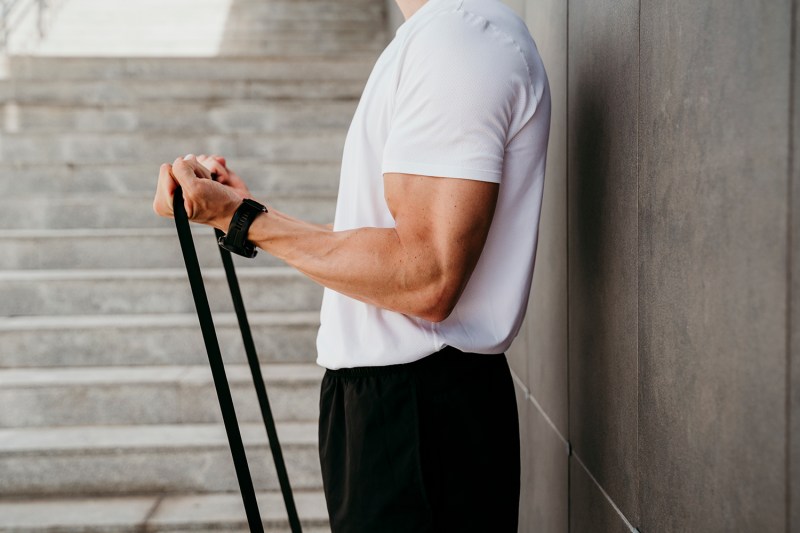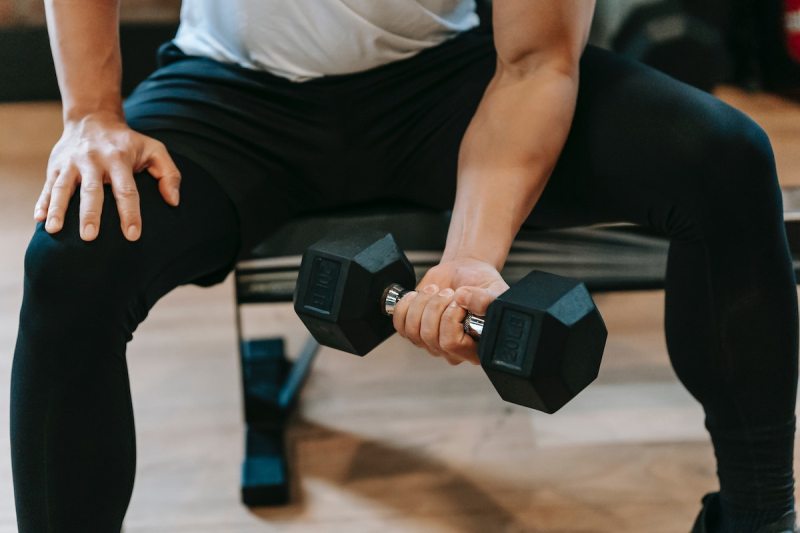Want bigger arms? If you’re like most gym-goers, the answer is yes. The biceps are one of the most popular muscle groups to train — but if you want serious results, it’s time to work smarter, not just harder. That means going beyond basic barbell curls.
Like many muscles, the biceps have multiple heads: the short head and the long head. Both contribute to strength and aesthetics in different ways. Let’s look at long head vs. short head bicep training and the exercises that can help you target each head.
Long head vs. short head: Anatomy of the biceps

The biceps brachii, commonly known as the biceps, is a muscle located on the front of the upper arm. The biceps have two heads: the long head and the short head.
What is the long head?
This head of the bicep starts from the top of your shoulder and runs down the arm to attach to one of the bones in the forearm. It’s the longer part of the biceps, and it helps you lift objects and rotate your arm.
What is the short head?
The short head starts from a bump near the front of the shoulder and joins the long head to form the biceps muscle. It also helps with bending your arm at the elbow and rotating your forearms.
Do you need to train both heads of the bicep?

The two heads of the biceps often work together to perform tasks for the body. For example, when you need to bend your arm or turn your palm upward, you have to use both heads to some degree. Nonetheless, if your goal is to build muscle, targeting each bicep head individually can lead to more complete development and better arm definition.
3 long head bicep exercises
Since the long head is on the outside of your arm, it’s generally what people notice first about you. When working long head biceps, you’re typically looking for exercises with a neutral or close grip.
Hammer curls

Instructions:
- Stand with your feet shoulder-width apart, holding a dumbbell in each hand. To do hammer curls the right way, your palms should face your body (maintain a neutral grip).
- Keep your elbows close to your sides throughout the movement to help keep the tension on your biceps.
- Slowly lift the dumbbells toward your shoulders by bending your elbows. Your palms should still face your body as you lift.
- When the dumbbells are at shoulder height, squeeze your biceps and pause for a second.
- Slowly lower the dumbbells back to the starting position, keeping your movements controlled.
Recommended sets and reps: 3 sets of 8 to 12 reps
Why this exercise works: Featuring a neutral grip, the hammer curl is excellent for targeting the long head bicep.
Incline dumbbell curls

Instructions:
- Adjust an exercise bench to a 45-degree incline.
- Sit back on the bench with a dumbbell in each hand, and let your arms hang down fully, with your palms facing forward.
- Keep your elbows close to your body, and don’t let them swing during the exercise.
- Slowly curl the dumbbells up toward your shoulders by bending at the elbows.
- When the weights reach shoulder height, squeeze your biceps and hold for a moment.
- Slowly lower the dumbbells back to the starting position, fully extending your arms.
Recommended sets and reps: 3 sets of 8 to 15 reps
Why this exercise works: Your elbow placement helps to stretch out the long head, maximizing the value of this exercise.
Drag curls

Instructions:
- Stand up straight with your feet shoulder-width apart, holding barbells with your palms facing up.
- As you begin to curl, focus on pulling your elbows back and keeping the bar close to your body.
- Instead of curling the bars straight up, drag them along your body by pulling your elbows back and bringing the bars up to your chest.
- When the bars reach chest height, squeeze your biceps and hold for a moment.
- Slowly lower the bars back to the starting position, keeping them close to your body.
Recommended sets and reps: 3 sets of 8 to 12 reps
Why this exercise works: This type of curl pulls your elbows back and behind you, maximizing its effectiveness for the long head.
3 short head bicep exercises
To target the short head, you’re going to want to do exercises that feature a supinated grip and in which you hold your arms lateral to your body.
Concentration curls

A study by the American Council of Exercise suggests that concentration curls cause the most bicep isolation because of how well they isolate the muscle. Here’s how to perform the exercise for optimal results.
Instructions:
- Sit on the edge of a bench with your legs spread apart. Hold a dumbbell in one hand.
- Lean forward slightly and place the back of your upper arm against the inside of your thigh, just above your knee. Your arm should hang straight down with the dumbbell in hand.
- Slowly curl the weight up toward your shoulder by bending your elbow. Keep the upper arm against your thigh to prevent it from moving.
- When the dumbbell reaches shoulder height, squeeze your bicep and hold for a moment.
- Slowly lower the dumbbell back down until your arm is fully extended.
- Perform the same number of repetitions on the other arm.
Recommended sets and reps: 3 sets of 8 to 12 reps
Why this exercise works: The combination of supination and flexion involved in this exercise makes it perfect to work the short head of the bicep.
Spider curls

Instructions:
- To perform spider curls, adjust an incline bench so that it’s almost flat or at a slight incline (around 30 to 45 degrees).
- Lie face down on the bench with your chest against the pad. Let your arms hang straight down over the edge, holding a barbell or dumbbells with your palms facing up.
- Slowly curl the weight up toward your shoulders by bending your elbows. Focus on keeping your arms stationary and only moving your forearms.
- When the weight reaches the shoulder height, squeeze your biceps and hold for a moment.
- Slowly lower the weight back down to the starting position, fully extending your arms.
Recommended sets and reps: 4 sets of 8 to 12 reps
Why this exercise works: This exercise keeps your arms lateral to your body (and works particularly well if your grip is wide).
Preacher curls

Instructions:
- Use a preacher curl bench and sit down with your upper arms resting on the padded surface. Your chest should be against the bench.
- Hold the barbell or dumbbell with an underhand grip (palms facing up).
- Slowly curl the weight up toward your shoulders by bending your elbows. Keep your upper arms pressed against the pad.
- When the weight reaches shoulder height, squeeze your biceps and hold for a moment.
- Slowly lower the weight back to the starting position, fully extending your arms.
Recommended sets and reps: 3 sets of 8 to 15 reps
Why this exercise works: The nature of the preacher curl keeps you from accidentally cheating and using other muscles, maximizing effectiveness.
Frequently asked questions

Which bicep head makes it look bigger?
The short head of the biceps contributes more to the overall width and “bump” of the biceps, making them look bigger, especially when viewed from the front. This head also gives the biceps a fuller appearance when the arm is flexed. Concentration curls and preacher curls are great exercises to target the short head.
Do bicep curls work the long or short head?
Bicep curls work both the long and short heads of the biceps, but the targeted head can vary depending on the type of curl. For example, hammer curls would bias the long head, while preacher curls would target the short head.
Which bicep head should I train more?
Determining which bicep head you should train more depends on your physique goals. For overall bicep size and fullness, focus on exercises that target both heads, like standard barbell curls. For a fuller appearance, however, it is expedient to train the short head more.
Now that you know how to target each bicep head, mix a few of these exercises into your next arm day, and start building arms that don’t just look big, but look complete.




